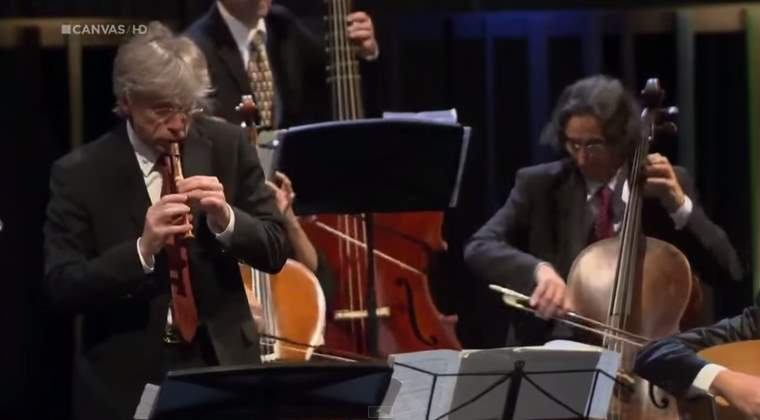Italian early music ensemble Il Giardino Armonico (the Harmonious Garden) performs Antonio Vivaldi’s La tempesta di mare (“The Storm at Sea”), a flute concerto in F Major (RV 433; P. 261), the first of Six Flute Concertos, Op. 10, published in the late 1720s. From the 25th anniversary of the ensemble in the summer of 2010 at the Residence Wurzburg. Conductor and recorder: Giovanni Antonini.
Antonio Vivaldi’s La tempesta di mare (“The Storm at Sea”)
Antonio Vivaldi’s “La tempesta di mare” (“The Storm at Sea”), a flute concerto in F Major (RV 433; P. 261), is a vibrant and evocative piece that exemplifies Vivaldi’s genius in creating vivid musical imagery. It is the first of his Six Flute Concertos, Op. 10, and stands out for its programmatic content, illustrating a sea storm through music. Composed in the Baroque era, this concerto showcases Vivaldi’s flair for dramatic contrasts, virtuosic demands, and the ability to paint a vivid scene with notes.
Giving a musical impression of a storm was a popular theme in baroque music. For instance, operas like Marin Marais’ Alcyone contained famous storm scenes. Telemann wrote a secular cantata La Tempesta (The Storm), TWV 20:42, after an Italian libretto by Metastasio. Vivaldi wrote several tempesta di mare concertos. Two variants of RV 433, RV 98 and RV 570, are in the chamber concerto and concerto grosso format respectively.
RV 98 is scored for flute, oboe, violin, bassoon, and continuo, from which Vivaldi created the RV 570 concerto grosso by adding orchestral violins to reinforce the solo oboe and violin, and a viola part doubling the bass at the upper octave. An unrelated tempesta di mare concerto, a violin concerto in E♭ major, RV 253, is included as No. 5 in Vivaldi’s Op. 8 Il cimento dell’armonia e dell’inventione. The Four Seasons, the first four concertos of that collection, also include a few musical depictions of stormy weather.
“La tempesta di mare” is structured in the fast-slow-fast pattern typical of the Baroque concerto, with each movement bringing to life different aspects of a tempestuous sea:
- Allegro: The first movement, marked Allegro, immediately plunges the listener into the heart of the storm. The music is dynamic and turbulent, with rapid passages in the flute depicting the howling wind and raging waves. The energetic rhythm and brisk tempo contribute to the sense of urgency and chaos of a storm at sea.
- Largo: In contrast, the Largo offers a moment of calm amidst the storm. It can be seen as the eye of the storm, where everything is momentarily peaceful and still. The flute’s melody is more subdued and reflective here, with a gentle accompaniment from the strings.
- Presto: The final movement, marked Presto, resumes the storm’s fury. It is fast-paced and vigorous, with the flute playing rapid, swirling melodies that mimic the gusts of wind and crashing waves. The movement’s lively tempo and energetic rhythms bring the concerto to an exhilarating close, capturing the chaotic climax of the storm.
“La tempesta di mare” is notable for its expressive solo flute part, which requires considerable virtuosity. Vivaldi, himself a violinist, had a remarkable ability to write effectively for other instruments, and this concerto is a fine example of his skill in writing for the flute. The soloist’s part is full of challenging runs and leaps, requiring agility and expressiveness to convey the storm’s power and drama.
The concerto is also a testament to Vivaldi’s skill in orchestration. He uses the string ensemble to create a backdrop that supports and interacts with the solo flute, contributing to the overall depiction of the stormy sea. The interplay between the soloist and the orchestra adds depth and dimension to the portrayal of the tempest.
“La tempesta di mare” remains a popular piece in the flute repertoire, admired for its vivid imagery and the technical demands it places on the soloist. It is a brilliant example of Vivaldi’s ability to use music to paint a picture, transporting listeners to the scene of a raging sea storm.
Sources
- La tempesta di mare (flute concerto) on Wikipedia
